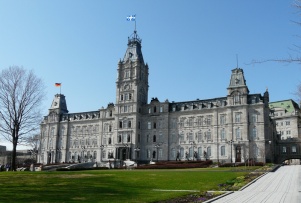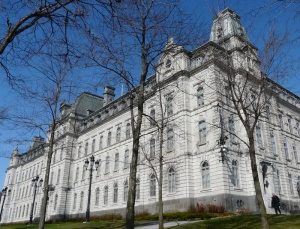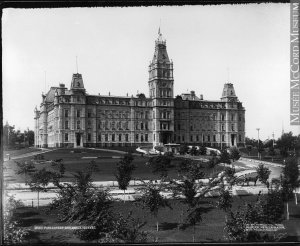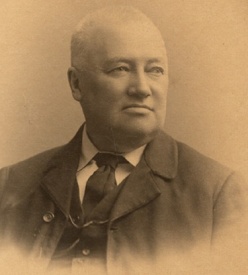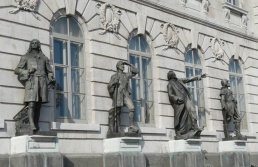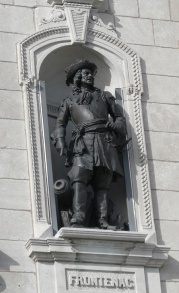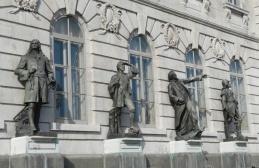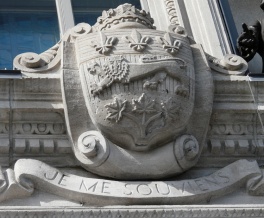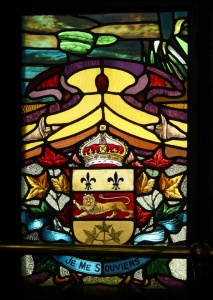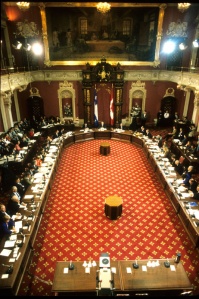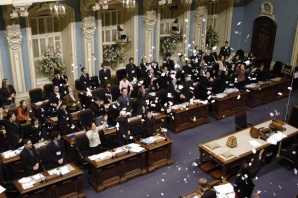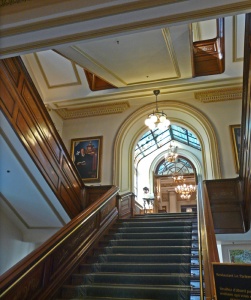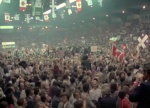
The Parliament Building of Quebec: A Place of Memory
par Godin, Richard
Erected between 1875 and 1886, the Quebec Parliament Building stands as one of the finest examples of Quebec’s architectural heritage. Its craftsmanship and style evoke the past, present and future of a nation committed to democracy. And its imposing freestone façade, distinctive silhouette and interior design all bring to mind—as its architect Eugène-Étienne Taché intended—the French origins of this North American nation. The building’s east-facing façade, just a stone’s throw from the fortifications of the Old City, is adorned with a series of sculptures that hearken back to significant events and figures in the founding of Canada and Quebec. Carved above the main entrance is Quebec’s motto, “Je me souviens.” A reference to Quebec’s evolution since 1534, the motto actualizes political history and reminds observers that to this day the parliament is the seat of the people’s assembly and their elected government.
Article disponible en français : Parlement de Québec : lieu de mémoire
“Je me souviens”
Eugène-Étienne Taché (1886)
The Incarnation of a Democratic Heritage
The Quebec Parliament Building, the heart of Quebec political life since 1884 (the year of its inauguration) and the seat of its legislative assembly and government, was designated a historic site in 1985 (NOTE 1) under Quebec’s Cultural Property Act. With a history dating back over a hundred years, the building aptly symbolizes the longevity of Quebec democracy and constitutes in itself a monument destined to nourish the collective memory of Quebecois. The overarching vision of its architect Eugène-Étienne Taché (NOTE 2) (1836–1912) endures to this day.
As a seat of democracy and political power, the Parliament Building boasts a rich political history, and as such, holds great value for Quebecois. But how should it be viewed from a heritage perspective? As part of the built heritage? As a cultural monument? Or perhaps both. One thing is certain: Eugène-Étienne Taché accomplished a remarkable feat with an architectural project embodying the values and history of an entire people.
From One Parliament to Another
The history of parliamentary life in Quebec is marked by a series of episodes revolving around the site of the legislative assembly and the government. From 1792 to 1838, the members of the Legislative Assembly of Lower Canada sat in the former chapel at the Bishop’s Palace (NOTE 3) on Côte de la Montagne. After London adopted the Act of Union in 1840, (NOTE 4) Quebec City lost its status as capital to Kingston. Four years later the Parliament was moved to Montréal. But in 1849 a fire forced the institution to move again, this time to Toronto which, as of 1850, alternated with Quebec City until a fire destroyed the Parliament Building there in 1854.
Quebec City regained its status as capital in 1856, and in 1860, the newly built (NOTE 5) Parliament Building (NOTE 6) opened its doors to parliamentarians. In 1864 it played host to the Quebec Conference, which led to the passing of the British North America Act and the creation of the Canadian Confederation in 1867. Ottawa became Canada’s permanent capital in 1865, in keeping with the wishes of Queen Victoria. (NOTE 7) With Confederation, Quebec City became the provincial capital; the Parliament Building on Côte de la Montagne served as the seat of government until it was destroyed by fire in 1883. (NOTE 8)
The whole period leading up to and surrounding Confederation was marked by political uncertainty. Fortunately, construction work on the new Parliament Building, which had been underway since 1877, was far enough along to allow parliamentarians to move into their new premises before the inauguration date, initially slated for 1884.
Architecture and the Memory of a Nation
Around 1875 Quebec City underwent a series of beautification projects sponsored by Lord Dufferin, (NOTE 9) Canada’s third governor general. Taking its cue from Dufferin, the province’s Conservative government led by Premier Charles Boucher de Boucherville decided to build the capital’s first major “edifice”—the Parliament Building. Instead of turning to more well-known architects like François-Xavier Berlinguet or Charles Baillairgé, the premier opted to hire Eugène-Étienne Taché to draw up the plans. The plans Taché presented were a clear reflection of the desire to achieve political stability and establish a lasting democracy.
From the very outset in 1875, the plans called for a number of architectural elements to reflect the motto that would be carved above the building’s main entrance —“Je me souviens”—and would eventually become Quebec’s official motto in 1939. Eugène-Étienne Taché was keenly aware of the importance attached to the project, and instead of adopting the emerging style of American modernism, he opted for the classical, neo-Renaissance (Second Empire) architecture in vogue in France at the time. He was also inspired by the Parliament Building in Ottawa, built between 1859 and 1866. Quebec’s Parliament Building was inaugurated on June 17, 1884, with the laying of the portico cornerstone. (NOTE 10)
Taché’s architectural choices stemmed from his firm desire to anchor Quebec’s political history in the public eye and memory once and for all. His primary objective was to underscore Canada’s French origins by integrating as many historical elements as possible into the building’s façade. The architect used these elements—a fountain, statues, bas reliefs, paintings, woodwork and other details—to link these origins to the rest of the history of the country’s founding and thereby imbue Québec’s motto with all its meaning. Essentially, the Parliament Building tells the tale of Quebec’s history.
Nothing was left to chance. A space was even set aside to commemorate future historic events. Taché’s design featured a square structure with four wings, each approximately 100 meters in length, around a closed central courtyard. His plan to integrate significant aspects of the history of New France and Canada was brought to life through a substantial “iconographic program” featuring 24 elements of Quebec and Canadian history. As historian Réal Bélanger points out, “This program was adapted a number of times during its development over nearly a century (1889–1969), but remained remarkably consistent over the years. The elements later added to the initial program were a way to depict history through the role politics has played in the lives of Quebecois.” (NOTE 11) The most recent statues to be added to the façade were those of Marie de l'Incarnation, Marguerite Bourgeoys and Paul de Chomedey de Maisonneuve, in 1969. (NOTE 12)
Like an open book, the new Parliament Building engages observant visitors in a dialogue, offering an interpretation of highlights from the history of a fledgling nation through its presentation of some of the adventurers who came to the continent from Europe, and the First Nations peoples who had occupied the land for millennia before them. Often considered a pantheon, the façade of the Parliament Building features a niche for each of 26 bronze sculptural works dedicated to a specific aspect of history, including two representing aboriginal peoples, 18 from the French regime, (NOTE 13) 4 from the British regime (NOTE 14) and 2 depicting values dear to the nation.(NOTE 15)
At the base of the façade on the edge of a fountain stands an aboriginal man—Fisherman with Spear (NOTE 16) (1891)—preparing to harpoon a fish. Immediately above him, four members of an Abenaki family gather in the forest during hunting season (A Halt in the Forest, 1889). (NOTE 17) Gazing out from their niches in the stone wall are prominent political figures, nuns, military men and adventurers who marked the history of the founding of Canada and Quebec. The central part of the façade features 13 historic personalities and two pairs of allegorical figures spread over five storeys. The left and right flanks of the façade each feature four bronze likenesses placed at ground level.
Two other features complete the ensemble. Just above the motto and topped by the British crown is Quebec’s coat of arms: three fleur-de-lys evoking the French origins of Quebec, the crowned lion recalling its ties to Great Britain, and a branch with three maple leaves symbolizing Upper and Lower Canada. The second feature consists of the bas relief carvings above the niches between the first and second floor windows that depict the coats of arms of the first governors and the names of several historic figures from the days of New France.
The building’s architectural elements are the work of thirteen accomplished and internationally recognized sculptors. The three main artists were Louis-Philippe Hébert, who created ten of the sculptures, Alfred Laliberté, who sculpted six, and Émile Brunet, four. Other notable contributors were sculptors Marc-Aurèle Suzor-Côté de Foy and Elzéar Soucy.
The Parliament Building has also marked time’s passage in a more conventional manner. Since 1888, a monumental clock designed by master clockmaker, jeweller and inventor Cyrille Duquet has been keeping time on three clock faces on the south, east and north sides of the central tower, atop which flies the “fleurdelisé,” Quebec’s official flag since 1948.
A Focal Point of Parliamentarism and Collective Identity
While he was drawing up the plans and layout for the building, architect Eugène-Étienne Taché never lost sight of its main function—to house the legislative assembly and seat of government. His vision is clearly reflected in the interior divisions of the Parliament Building, where the architect used art throughout to convey Quebec’s democratic history and collective memory. (NOTE 18)
The many pictorial works, paintings, frescoes, stained glass panels and sculptures also contribute to the building’s overall eloquence. But the Parliament Building is above all a physical space infused with the decorum one expects of the seat of political power. Like the exterior façade, the interior of the building features decorative elements and symbols that call to mind Quebec’s intangible heritage and national identity, namely religion, language and history.
The Parliament Building houses the National Assembly Chamber, long known as the Green Room, and the Legislative Council Chamber or Red Room,(NOTE 19) the ancestor of the senate. With the introduction of televised debates at the National Assembly in 1978,(NOTE 20) the walls of the Green Room were repainted blue,(NOTE 21) hence its current nickname, the “Blue Room.” Not surprisingly, Taché designed both chambers with the traditional British parliament’s face-to-face seating pattern as opposed to the semicircular layout of many European countries.
The near-perfect symmetry of the two chambers is quite remarkable. Separated by a monumental central staircase in the front of the building, their layout—a two-storey rectangular plan—is virtually identical. Both feature an overhanging gallery supported by a colonnade where visitors can watch the parliamentary proceedings and debates. In addition, each chamber boasts a clock designed by Cyrille Duquet. The only difference between the two is the press gallery balcony built into the monumental main entrance of the Blue Room, from which journalists have reported on parliamentary sessions since 1909.(NOTE 22)
At one end of both the chambers sits a throne crowned with a wood-sculpted coat of arms that recalls Quebec’s close ties to the British monarchy.
In the Blue Room, the president of the National Assembly is seated on the throne. To his right is the fleurdelisé flag, and above his head, a crucifix—symbol of the Catholic religion. The presence of the cross in the chamber was called into question during the 2007 and 2008 Consultation Commission on Accommodation Practices Related to Cultural Differences. The Commission’s final report stated that “In the name of both the separation of the State and the churches and State neutrality, we believe that the crucifix should be removed from the wall of the National Assembly, which is the very embodiment of the constitutional state.”(NOTE 23)
In response, the members of the National Assembly unanimously adopted the following motion: “That the National Assembly reiterate its desire to promote the language, history, culture and values of the Québec nation, foster the integration of each person into our nation in a spirit of openness and reciprocity, and express its attachment to our religious and historic heritage represented particularly by the crucifix in our Blue Room and our coat of arms adorning our institutions.”(NOTE 24)
With the abolition of the Legislative Council in 1968, the throne was removed. Today the Red Room is used for parliamentary committee sessions and official events of a symbolic nature. For example, under the Act respecting the Ordre national du Québec, every year the government recognizes the civic engagement of people from Quebec and elsewhere by holding a ceremony to award recipients the title of Grand Officier, Officier or Chevalier de l'Ordre du Québec.
Another key decorative piece is the painting entitled The Language Debate by Charles Huot (1885–1930), which speaks to this significant aspect of Quebec’s identity. The massive painting has been hanging above the throne at the National Assembly since 1913. It depicts the acrimonious debate on January 21, 1793 at the House of Assembly of Lower Canada (then housed at the Bishop’s Palace in Quebec City) over which language should be used in the chamber. French was eventually voted as the language of choice. This historic canvas was commissioned around 1910 along with another painting entitled The Sovereign Council that emphasizes the French origins of Canada and Quebec and today hangs in the same location in the Red Room.
In addition to these main decorative elements, a host of other remarkable treasures can be found at the Parliament Building, two of which—the mace and the clerks’ table—play an important role in the rituals of the National Assembly. At each parliamentary sitting, the president of the Assembly enters the chamber followed by the sergeant-at-arms bearing the mace, a large, ornate staff that symbolizes both the power to make laws, as granted by the British monarchy, and the legitimate power of the Assembly to protect its constitutional rights “against external threats.”
Upon entering the chamber, the sergeant-at-arms places the mace on the clerks’ table, the crowned end turned towards the government, to the president’s right. In order for legislation passed during parliamentary proceedings to be valid, the mace must stay on the table for as long as the president remains in his chair. This British tradition is still in place at the parliaments in London, Ottawa and Toronto, to name a few.
Lastly, the clerks’ table sits in the centre of the National Assembly Chamber, in front of the president. Since 1886,(NOTE 25) the National Assembly’s secretary general and table officers have used it to handle the official documents tabled during parliamentary proceedings.
The Parliament Building has gracefully withstood the passage of time, undergoing relatively few modifications aside from the addition of three adjacent buildings,(NOTE 26) various modernization projects and embellishments to the grounds. Two dramatic events also left their mark in the annals of the Parliament Building. The first was a dynamite attack on the façade in 1884 and the second was the shooting rampage in 1984 by army corporal Denis Lortie, a tragedy that left three administrative staff members dead and 13 others injured. Since 1984, various security measures have been put in place but democratic access to this place of collective memory has been maintained.
Richard Godin, Ph.D.
Sociologist
NOTES
1. The complex includes the Parliament Building (1877–1886), Pamphile Le May building (1910–1915), Honoré Mercier building (1912–1917) and Le Parlementaire Restaurant building (1922).
2. Eugène-Étienne Taché was born into a well-to-do French Canadian family on October 25, 1836, in Montmagny. He was the son of Sir Étienne-Paschal Taché, who became premier of the province of Canada and one of the Fathers of Confederation. A civil engineer, public servant and surveyor, Taché was also a self-taught architect. He was the assistant commissioner (deputy minister) of Crown lands for Quebec, a position he occupied until his death on March 13, 1912. Lucie K. Morriset and Luc Noppen, (2000), Dictionary of Canadian Biography Online, “Taché, Eugène-Étienne”. [Online] http://www.biographi.ca/009004-119.01-e.php?&id_nbr=7730&interval=25&&PHPSESSID=5coe1df4sd474nqns5nkcmjkn2&PHPSESSID=5coe1df4sd474nqns5nkcmjkn2
3. First leased from the Church, the building was purchased by the government in 1831. Major work was undertaken at the site through 1833: the addition of a new wing on the Bishop’s Palace, demolition of the chapel and construction of the central parliament building. Between 1852 and 1853 the rest of the palace was torn down to make space for a new wing.
4. The Act of Union called for the establishment of a single government. Lower Canada became the Province of Quebec and Upper Canada, Ontario.
5. The Parliament Building was located on the same spot as the former Bishop’s Palace at the present-day site of Montmorency Park, at the top of Côte de la Montagne.
6. After the fire in 1854, a new parliament building was built between 1859 and 1860.
7. The decision dates back to 1857.
8. According to newspaper reports, the Parliament Building was “gravely” damaged by fire, which was started accidentally. The fire apparently broke out in the Legislative Council Chamber and spread rapidly to the rest of the building. L’Événement, (1883) “Conflagration: La bâtisse parlementaire réduite en cendres,” April 20, p. 4.
9. The work, which was carried out between 1874 and 1880, involved renovating Quebec’s military installations, preserving its walls, erecting the Saint-Louis and Kent gates and building the Dufferin Terrace.
10. Potvin, Damase, (1942) Aux fenêtres du Parlement de Québec, Éditions de la Tour de Pierre, Québec.
11. Bélanger, Réal, (2001) “L’hôtel du Parlement, symbole de l'État du Québec en devenir (1867-1982),” in Serge Courville and Robert Garon, Atlas historique du Québec. Québec, ville et capitale, Sainte-Foy, PUL, p. 395.
12. These three statues were the work of sculptor Émile Brunet (1892–1977).
13. The figures represented are Pierre Boucher de Boucherville, Jean Talon, Pierre Le Moyne D'Iberville, Louis Joliet, Jacques Marquette, Pierre Gaultier de Varennes et Sieur de La Verendrye, Charles-Michel de Salaberry, François-Gaston de Lévis, Father Jean-Jacques Olier, Paul de Chomedey de Maisonneuve, Louis-Joseph de Montcalm, Father Nicolas Viel, Father Jean de Brébeuf, Louis de Buade (comte de Frontenac), Monseigneur de Laval, Samuel de Champlain, Marie de l’Incarnation and Marguerite Bourgeois.
14. The figures represented are Guy Carleton, Baron of Dorchester (governor); Robert Baldwin (premier), James Bruce Lord Elgin (governor), General James Wolfe (victor at the Battle of the Plains of Abraham, in 1759).
15. These values were “poetry and history” and “religion and country.”
16. Work of Quebec sculptor Louis-Philippe Hébert (1850–1917).
18. Deschênes, Gaston and Francesco Bellomo, (2007) L'hôtel du Parlement: Mémoire du Québec, Éditions Stromboli, Saint-Lambert.
19. The colour red was traditionally associated with the English aristocracy, while green was most likely considered the colour of the people. National Assembly of Québec, (2010) The ABC of the National Assembly, Traditions and Symbols. [Online]. http://www.assnat.qc.ca/en/abc-assemblee/organisation-travaux-assemblee/symboles.html
20. The first National Assembly Channel broadcast was aired on October 3, 1978.
21. The colour change was a technical decision, as blue was better suited for television.
22. Not to be confused with the National Assembly press gallery, a not-for-profit corporation founded in 1958 by parliamentary journalists and headquartered in the André Laurendeau building. “This gallery, which journalists refer to fondly as ‘the perch,’ sits approximately four metres above the floor at the back of the Green Room. While the overhanging balcony looking down over either side of the main doors provides excellent views, it is rather far removed from the proceedings.” Saint-Pierre, Jocelyn. (1984) “La presse et l'information politique au Québec 1892-1920,” in Bibliothèque de l'Assemblée nationale Bulletin, Vol. 14, No. 3, p. 60.
23. Bouchard, Gérard and Charles Taylor (2008), Building the Future. A Time for Reconciliation. Consultation Commission on Accommodation Practices Related to Cultural Differences, Final Report, p. 179.
24. National Assembly of Québec. (2008) Parliamentary proceedings. 38th legislature, first session (May 8, 2007 to November 5, 2008). Votes and Proceedings of the Assembly. Thursday, May 22, 2008. Vol. 40, No. 87. Motions without notice. “Reiterate the National Assembly’s desire to promote the language, history, culture and values of the Quebec nation, foster the integration of each person into our nation in a spirit of openness and reciprocity, and express its attachment to our religious and historic heritage”
25. The first clerks’ table (1886 to 2007) has been designated a heritage object, and is on display at the Parliament Building.
26. Pamphile Le May building (1910–1915), Honoré Mercier building (1912–1917), Le Parlementaire Restaurant building (1922).

Additional DocumentsSome documents require an additional plugin to be consulted
Images
-
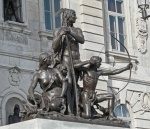 « La halte dans la fo
« La halte dans la fo
rêt », devant l... -
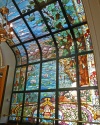 Côté nord du vitrail
Côté nord du vitrail
menant au resta... -
 Côté sud du vitrail m
Côté sud du vitrail m
enant au restau... -
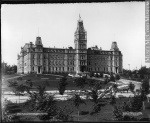 Édifices du Parlement
Édifices du Parlement
, Québec, QC, v...
-
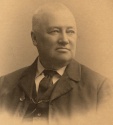 Eugène-Étienne Taché
Eugène-Étienne Taché
-
 Façade du Parlement :
Façade du Parlement :
statues de Pie... -
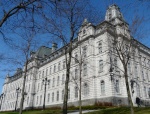 L'aile sud du Parleme
L'aile sud du Parleme
nt -
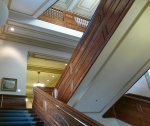 L'escalier central
L'escalier central
-
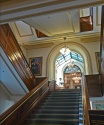 L'escalier central me
L'escalier central me
nant aux salles... -
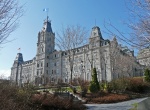 La façade du Parlemen
La façade du Parlemen
t -
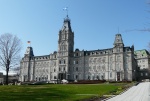 La façade du Parlemen
La façade du Parlemen
t -
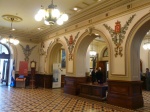 Le hall central du Pa
Le hall central du Pa
rlement
-
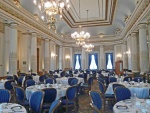 Le restaurant Le Parl
Le restaurant Le Parl
ementaire -
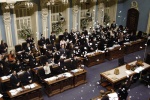 Le Salon Bleu, lors d
Le Salon Bleu, lors d
'une simulation... -
 Le Salon Rouge au mom
Le Salon Rouge au mom
ent de la Commi... -
 Les armoiries du Québ
Les armoiries du Québ
ec dans le vitr...
-
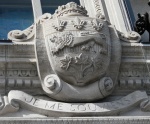 Les armoiries du Québ
Les armoiries du Québ
ec et la devise... -
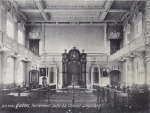 Salle du conseil légi
Salle du conseil légi
slatif, édifice... -
 Statue de Frontenac s
Statue de Frontenac s
ur la façade -
 Statue de Lord Elgin
Statue de Lord Elgin
sur la façade

